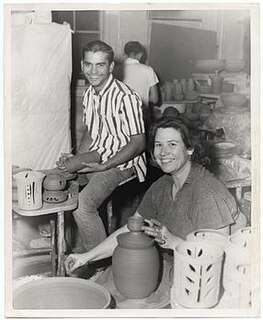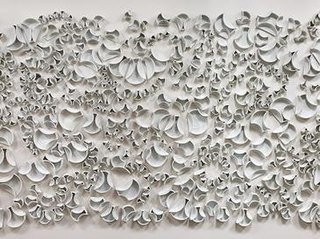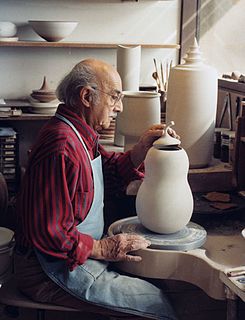Akio Takamori was a Japanese-American ceramic sculptor and was a faculty member at the University of Washington in Seattle, Washington.
D. Wayne Higby is an American artist working in ceramics. The American Craft Museum considers him a "visionary of the American Crafts Movement" and recognized him as one of seven artists who are "genuine living legends representing the best of American artists in their chosen medium."

Roseline Delisle was a Canadian ceramic artist.
John Mason was an American artist who did experimental work with ceramics. Mason's work focused on exploring the physical properties of clay and its "extreme plasticity". One of a group of artists who had studied under the pioneering ceramicist Peter Voulkos, he created wall reliefs and expressionistic sculptures, often on a monumental scale.

Ralph Bacerra was a ceramic artist and career educator. He lived and worked in Los Angeles, California.
Regis Brodie is a tenured Professor of Art at the Department of Art and Art History at Skidmore College in Saratoga Springs, NY and a potter. Since 1972, he has been serving as the Director of the Summer Six Art Program at Skidmore College. He also wrote a book called The Energy Efficient Potter which was published by Watson-Guptill Publications in 1982. He started the Brodie Company in 1999 in the interest of developing tools which would aid the potter at the potter's wheel.
Adrian Saxe is an American ceramic artist who was born in Glendale, California in 1943. He lives and works in Los Angeles, California.

Arnold Zimmerman (1954-2021), also known as Arnie Zimmerman, was an American sculptor and ceramic artist. His work ranged from monumental to miniature, and abstract to figurative, encompassing totemic vessel forms, tabletop sculpture and figures, murals, and room-size installations. He was part of a multi-decade, 20th-century shift in American ceramics during which artists challenged clay's identification with function and craft, engaging fine-art domains such as emotional expression, social commentary, figuration and narrative. Zimmerman first gained recognition in the 1980s for deeply carved, architectonic sculptures characterized by rough physicality, rhythmic surfaces, gestural presence and Italian Romanesque influences. In the mid-1990s, he shifted to figurative work that critic Donald Kuspit wrote, examined the interaction of finite man and infinite matter, artist and creative work: "There is a sense of futility and folly as well as seemingly senseless idealism and innocence built into Zimmerman's parables of the all-too-human."

Annabeth Rosen is an American sculptor best known for abstract ceramic works, as well as drawings. She is considered part of a second generation of Bay Area ceramic artists after the California Clay Movement, who have challenged ceramic traditions involving expression, form and function and helped spur the medium's acceptance in mainstream contemporary sculpture. Rosen's sculptures range from monumental to tabletop-sized, and emerge out of an accumulative bricolage process combining dozens or hundreds of fabricated parts and clay fragments and discards. Reviewers characterize her art as deliberately raw, both muscular and unapologetic feminine, and highly abstract yet widely referential in its suggestions of humanoid, botanical, aquatic, artificial, even science-fictional qualities. Critic Kay Whitney wrote that her work is "visceral in its impact, violent even, but also sensual and evocative" and "floats between the poles of the comic and the mordant."

Rupert Deese was an American ceramic artist. He is known for innovative design and decoration of high fired ceramics. Deese wrote "It is my hope in making these vessels that as the perception of their beauty diminishes over time, they will sustain themselves by pleasant usefulness."
Steven Montgomery is an American artist most often associated with large scale ceramic sculpture suggesting industrial objects or mechanical detritus. He received a Bachelor of Philosophy degree from Grand Valley State University in Allendale, Michigan and a Master of Fine Arts from the Tyler School of Art of Temple University in Philadelphia, Pennsylvania.
Chris Weaver is a New Zealand potter. He has exhibited widely in New Zealand and internationally, winning many awards. His work is held in public museum collections in New Zealand, Australia and Japan.

Monica E. Rudquist is a ceramic artist working out of Minneapolis, Minnesota. She is known for her distinctive "spiraling shapes" and works primarily in porcelain. In addition, her work features wheel-thrown functional wares as well as large-scale, abstract wall installations.

Harrison Edward McIntosh was an American ceramic artist. He was an exponent of the Mid-century Modern style of ceramics, featuring simple symmetrical forms. His work has been exhibited in venues in the United States including the Smithsonian and internationally including at the Louvre in France.
Garth Clark is an art critic, art historian, curator, gallerist, and art dealer from Pretoria, South Africa.
Richard Shaw is an American ceramicist and professor known for his trompe-l'œil style. A term often associated with paintings, referring to the illusion that a two-dimensional surface is three-dimensional. In Shaw's work, it refers to his replication of everyday objects in porcelain. He then glazes these components and groups them in unexpected and even jarring combinations. Interested in how objects can reflect a person or identity, Shaw poses questions regarding the relationship between appearances and reality.
Kurt Weiser is an American ceramicist and professor. His work—explorations of the relationship between man and nature through narratives rendered in vivid color—are described as "Eden-like." His work has often taken the form of teapots, vases, and cups, though he has recently begun crafting globes as well. Weiser is currently the Regents Professor at Arizona State University's School of Art.
Chris Gustin is an American ceramicist. Gustin models his work on the human form, which is shown through the shape, color, and size of the pieces.

Nancy Selvin is an American sculptor, recognized for ceramic works and tableaux that explore the vessel form and balance an interplay of materials, minimal forms, and expressive processes. She emerged in the late 1960s among a "second generation" of Bay Area ceramic artists who followed the California Clay Movement and continued to challenge ceramic traditions involving expression, form and function, and an art-world that placed the medium outside its established hierarchy. Her work has been exhibited at the Los Angeles County Museum of Art (LACMA), Denver Art Museum, Daum Museum of Contemporary Art and Kohler Arts Center, and belongs to the public art collections of LACMA, the Smithsonian Institution, Oakland Museum of California, and Crocker Art Museum, among others. Critic David Roth has written, "Selvin's position in the top rank of ceramic artists has come through a process of rigorous self-examination … what differentiates [her] is that she eschews realism and functionality, indicating a level of intellectual engagement not always found among ceramicists." Writer and curator Jo Lauria described Selvin's tableaux as "elegiac and stylistically unified" works that serve as "forceful essays on the relationship between realism and abstraction, object and subject, decoration and use." Selvin lives and works in the Berkeley, California area.

Jennifer Elizabeth Lee is a Scottish ceramic artist with an international reputation. Lee's distinctive pots are hand built using traditional pinch and coil methods. She has developed a method of colouring the pots by mixing metallic oxides into the clay before making. Her work is held in over forty museums and public collections worldwide, including the Metropolitan Museum of Art in New York, the Philadelphia Museum of Art, the Los Angeles County Museum and the Victoria and Albert Museum. In 2018 Lee won the Loewe Craft Prize, an award initiated by Jonathan Anderson in 2017. The prize was presented to her at an awards ceremony at The Design Museum in London.








